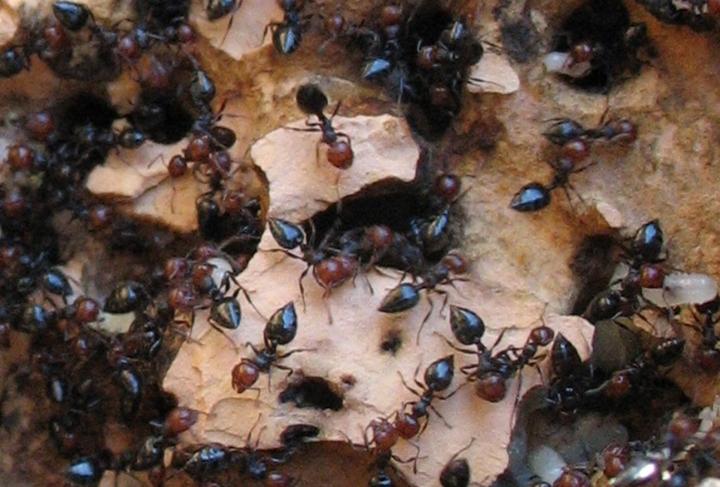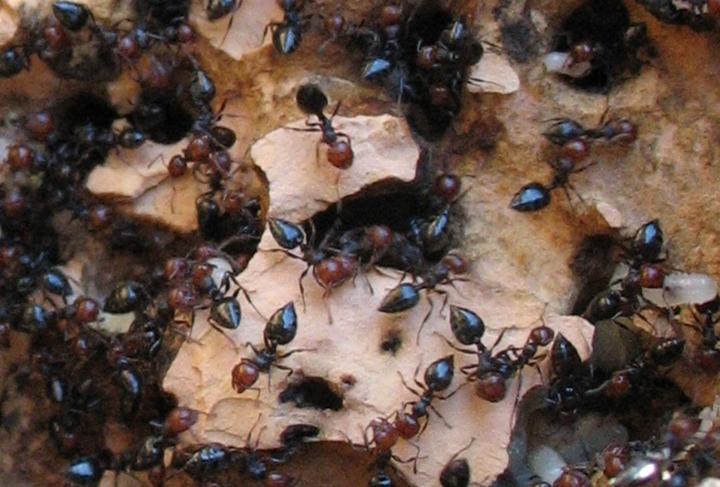
Credit: photo/©: Florian Menzel, JGU
The bodies of ants and other insects are covered with a thin, wax-like layer that protects them from desiccation and enables them to exchange information, in social insects, for instance, to differentiate between enemies and nestmates. Its double function makes this layer not only essential to survive but also unique to the extent that it can serve as an unambiguous characteristic for the identification of an insect species, similar to a fingerprint. The layer makes it possible to differentiate even between closely related species. This is due to its composition of cuticular hydrocarbons that form a specific chemical profile. Biologists at Johannes Gutenberg University Mainz (JGU) in Germany recently established that ants can adapt their hydrocarbon profile quickly during the course of evolution and rapidly adapt to external selection pressures.
The cuticular hydrocarbons (CHCs) of a single insect can consist of more than 100 different substances and strongly differ between insect species. They are found on the cuticle of virtually every insect and prevent water loss, thus enabling them to survive in arid environments. CHCs are also the main communication channel for social insects in that they provide information about the colony origin of its carrier, about its caste and tasks within the colony, and, in the case of queens, about their reproduction status. They are thus irreplaceable to ensure the functioning of an insect colony. Many solitary insects also use them as sex pheromones.
"We still find the evolution of such complex traits with multiple functions very puzzling," explained evolutionary biologist Dr. Florian Menzel. He is especially interested in whether CHC profiles remain relatively stable during the course of evolution–similar to morphological traits such as body size or shape–or whether they can change faster and more flexibly than other traits during evolution.
Related ant species with different CHC profiles
Menzel and his cooperation partners from the Smithsonian Institution in Washington, D.C., and the University of Würzburg, Germany, conducted research on ants of the genus Crematogaster, one of the most species-rich ant genera with about 1,000 species worldwide. These acrobat ants can raise their abdomen over their head to release venom or repelling substances into the environment and the surrounding air. The researchers selected 43 ant species from the Crematogaster genus from five continents and examined them concerning their relatedness and their chemical profiles. "We wanted to know whether species that are adjacent to one another on the phylogenetic tree have similar hydrocarbon profiles," said Menzel.
In fact, the evolutionary biologist found no such correspondence. Related species can thus have significantly different CHC profiles. These profiles can change faster than morphological characteristics or behavioral patterns during the course of evolution. "The ants obviously have a large genetic arsenal at their disposal, which they can adapt with great speed to change their CHC profile," Menzel explained. He suspects that this enables the ants to adapt their chemical signals over short evolutionary periods if necessary, for instance, due to changes in environmental conditions.
Precipitation influences chemical fingerprint
In another cooperative study including 38 Camponotus species and 42 Crematogaster species from different climatic zones ranging from temperate to tropical, the German and US-American biologists demonstrated that climate also exerts selection pressures on the chemical fingerprint. Their study revealed a clear correlation of CHC composition and precipitation: ant species from humid regions such as the montane rainforests of Malaysia or Uganda have more alkenes and fewer dimethylalkanes in their CHC profile than ants from arid regions such as the Mediterranean. "We think this is due to the different abilities of each compound to protect against desiccation," Menzel explained. Surprisingly, the temperature of the habitat has no influence on CHC composition. However, another result shows that so-called parabiotic ants, which symbiotically live in one nest together with another ant species, have yet different CHC profiles. They differ significantly from ants that do not live in such a symbiosis, suggesting that their particular CHC profiles represent an adaptation to reduce aggression between the two co-habiting species.
The Mainz-based evolutionary biologists will further collaborate with colleagues from the Senckenberg Gesellschaft in Frankfurt, Germany, and the University of Würzburg to find out how ants can adapt their CHC profiles so quickly. Their research will focus on the parabiotic species Crematogaster levior and Camponotus femoratus, which live together in so-called ant gardens in the tropical rainforest of South America and show an enormous chemical diversity. The two species living side by side in these unusual joint nests forage together and sometimes even feed one another. Their symbiotic relationship, the symbiosis with the plant species of the ant gardens, and the reasons for the variety of their CHC profiles have yet to be studied.
###
Media Contact
Dr. Florian Menzel
[email protected]
49-613-139-27848
@uni_mainz_eng
Related Journal Article
http://dx.doi.org/10.1111/jeb.13115





